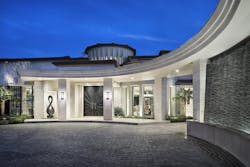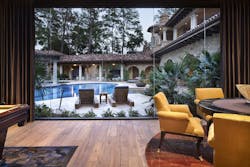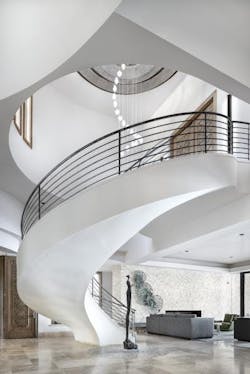Backstory: Well-Rounded
Since his first design/build project in 1982—a spec house funded by all of his savings and a bank loan with 18 percent interest—architect Luis Jauregui has added to his arsenal of architectural and building services, which include real estate, development, and interior design.
A native of Mexico, Jauregui came to the U.S. for college when, in 1971, during his architecture studies at the National Autonomous University of Mexico, the school went on strike. He graduated from Texas A&M University with a bachelor’s in environmental design and received a master of architecture degree two years later. When Jauregui was a freshman, a teacher recommended him for a job with an architect. “I had the opportunity to work with architects throughout my college education, so when I graduated with my master’s I already had six years working in an architecture office,” Jauregui says. “It was a huge advantage.” He got licensed just two years after graduation.
Jauregui (pronounced how-REH-ghee) began his practice right away, taking both commercial commissions and some residential jobs, “doing design only, as I was trained at Texas A&M,” he says. “But, coming from Mexico, where the majority of architects have their own construction companies, I felt architects should implement their work. I had that itch.” So he raided his savings and got a bank loan. That first project sold during the framing stage. “That’s what defined me,” Jauregui says. “I took the money I’d made and bought more lots and began building more homes. I was very aware that what I was starting was not just an architectural office or a builder’s office. I was starting an entrepreneurial endeavor.”
Meet the Market
With the business model in place, Jauregui had to temper some of his design inclinations to be successful in Austin, Texas, where he’d set up shop. Influenced by the work of Luis Barragán and his disciple, Ricardo Legorreta, both Mexican minimalists, he says, “I love the massive quality of their modern architecture. But I wasn’t going to sell Barragán and Legorreta in Austin.” So, Jauregui just tried to do good design “without losing sight of the fact that these products were for sale on the open market, and that began to influence my designs,” he says.
Barragán’s and Legorreta’s work has “a lot of influences from Indian and pre-Hispanic architecture, the pyramids, and the solid expression of architecture from the Spanish,” Jauregui observes. He also notes the use of color. “It’s very Mexican to have rich magentas, bright yellows, and deep blues combined with whites and natural materials.” Jauregui translated that style into robust columns, thicker walls, and simpler lines. Luck and timing played a role. “Before we knew it,” he says, “adobe Southwestern became popular, and that worked in my favor.”
In 2002 Jauregui opened an office in Houston. Styles there were more grand and opulent at the time, he says. “But it was another bit of good timing on our part. Houston has changed to embrace a more relaxed style for the high-end luxury market—which is what Austin is about and what’s been successful for us there.”
A Family Business
Now Jauregui Architecture, Construction, & Interiors has 35 employees, which include 10 architects; the construction company’s estimators, superintendents, project managers, and purchasing people; and an interior design team of six. Jauregui’s wife, Susan, a real estate broker, runs sales and marketing. “She’s the rainmaker,” he says. One daughter, an interior designer, has been with the firm for eight years, another daughter is a project coordinator, and a nephew and niece also work for the firm. A family business can be stressful, but Jauregui says they leave it all at the office.
“We’re intense at work. We relax at home. I don’t have an office at home,” he says.
And Jauregui also makes time for professional commitments. He has been president of Austin’s Home Builders Association and currently is president of the American Institute of Architects’ Austin chapter. He’s also one of the founders of AIA’s Custom Residential Architects Network. He lectures, travels, and last fall was named an Outstanding Alumni in Texas A&M’s college of architecture—an honor awarded to just 1 percent of the architecture school’s alumni. Last year NAHB named the company Custom Builder of the Year.
Jauregui believes it’s important to give back and he encourages young architects and builders to gravitate toward design/build. “It’s a great advantage for your clients,” he says. “You have a better product to offer. It’s an easier sell. For architects, there’s a great increase in earning potential, and for the builder it’s a better way to control the product.” But Jauregui worries about the industry’s labor shortage and believes immigration policies add to the problem. He says, “a well-regulated guest worker program is going to have to be part of the solution, but it’s a very charged subject.”
About 20 percent of Jauregui’s business is now speculative, from buying land to putting together the design and building the project. Each segment of the business is a profit center—the company designs everything it builds and builds everything it designs. After 35 years, Jauregui says he’s still having a blast. “I’m not doing things too differently from the way I’ve always done them,” he says.” We have a good reputation, and the phone rings a little bit more.”
Stacey Freed writes about design from her home in Pittsford, N.Y.


